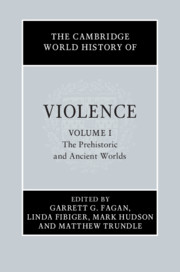Book contents
- The Cambridge World History of Violence
- The Cambridge History of Violence
- The Cambridge World History of Violence
- Copyright page
- Contents
- Figures
- Maps
- Contributors to Volume i
- General Introduction: Violence in World History
- Introduction to Volume I
- Part I The Origins of Conflict
- Part II Prehistoric and Ancient Warfare
- Part III Intimate and Collective Violence
- Part IV Religion, Ritual and Violence
- 21 Ritual Violence and Headhunting in Iron Age Europe
- 22 Ritual Killing and Human Sacrifice in the Ancient Near East
- 23 Violent Sacrifice in the Ancient Greek and Roman Worlds
- 24 Combat Sports in Ancient Greece and Rome
- 25 Religious Violence in Late Antiquity
- Part V Violence, Crime and the State
- Part VI Representations and Constructions of Violence
- Index
- References
25 - Religious Violence in Late Antiquity
from Part IV - Religion, Ritual and Violence
Published online by Cambridge University Press: 13 March 2020
- The Cambridge World History of Violence
- The Cambridge History of Violence
- The Cambridge World History of Violence
- Copyright page
- Contents
- Figures
- Maps
- Contributors to Volume i
- General Introduction: Violence in World History
- Introduction to Volume I
- Part I The Origins of Conflict
- Part II Prehistoric and Ancient Warfare
- Part III Intimate and Collective Violence
- Part IV Religion, Ritual and Violence
- 21 Ritual Violence and Headhunting in Iron Age Europe
- 22 Ritual Killing and Human Sacrifice in the Ancient Near East
- 23 Violent Sacrifice in the Ancient Greek and Roman Worlds
- 24 Combat Sports in Ancient Greece and Rome
- 25 Religious Violence in Late Antiquity
- Part V Violence, Crime and the State
- Part VI Representations and Constructions of Violence
- Index
- References
Summary
This chapter starts by locating the common association of religious violence with Christianity and late antiquity in a Protestant polemic which was further developed by the Enlightenment. New approaches have started to question this master narrative, however, by highlighting the limited number of temple destructions and other paradigmatic acts of religious violence, contextualising religious violence within the prominent role played by violence in the later Roman Empire, and dissociating violent language from violent acts. Moral principles and specific understandings of religion and history produce a Christian discourse that makes violence highly visible because the church is associated with peace and society with violence. Two well-known case studies illustrate the point. First, the destruction of the Serapeion in Alexandria (391 CE) allows us to notice how the historian Rufinus constructs a narrative playing on Christian understandings of martyrdom and pagan, sacrificial violence. Second, the letter of Severus of Minorca on the conversion of the Jews (418 CE) is not an aggressive tract to promote widespread conversion of the Jews, but a defensive document that tries to free Severus from accusations of having stirred up violence.
Keywords
- Type
- Chapter
- Information
- The Cambridge World History of Violence , pp. 512 - 530Publisher: Cambridge University PressPrint publication year: 2020

